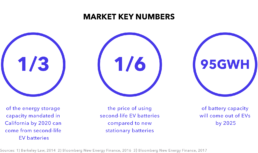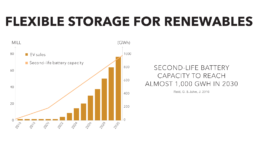As the mobility sector transitions to an electric future, we will soon see a wave of used batteries becoming obsolete when their capacity becomes too low to use in electric vehicles (EVs). However, by repurposing mobile EV batteries in new stationary settings, it is possible to double battery life cycles to more than 20 years.
The huge growth in the number of electric vehicles (EVs) on our roads means a growing supply of used batteries, which are considered depleted when their capacity is reduced to 80%. While no longer suitable for mobile energy storage, these batteries could still have long lives in stationary settings. Second-life batteries can be used at utility-scale, commercial-scale, and even in community or local power applications. Extending the battery life contributes to reducing waste and resource exploitation.
Even though established recycling technology exists, repurposing EV batteries to delay the recycling process extends the value of each battery and reduces the overall environmental impact. The University of California, San Diego, was among the first large energy users to demonstrate the potential of second-life batteries in 2013, when it networked 108 kilowatts of batteries from BMW’s Mini E, connecting to the microgrid that provides almost all of the campus’s electricity needs.

Products and Services
Second-life batteries can be used in a range of applications, including residential electricity storage. By integrating used EV batteries, homes can store energy from solar and other renewable sources, or draw from the grid when electricity is cheapest, providing benefits for grid balancing and consumer costs. Such systems are already on the market, such as Nissan and Eaton’s collaboration: xStorage.
Expanding into the used EV battery market is attractive for car manufacturers, as it extends the batteries’ revenue lifetime and increases the EV resale value. Innovative models, such as providing batteries as a service, are already being adopted by firms such as Renault. The company leases batteries instead of selling them, meaning that once batteries reach the end of the road, the manufacturer can re-engineer or recycle them for future use.
Second-life battery applications can help to scale EV technology, lower costs and balance demand on the grid, and can be used in combination with renewable energy to lower carbon emissions.

Market Size and Demand Drivers
There are expected to be as many as 37 million EVs on the road by 2025. The global electric vehicle market is forecast to grow at a CAGR of 41% between 2014 and 2023. Worth an anticipated $93.1 billion by 2025, the lithium-ion battery market is growing at a CAGR of 17%, representing significant business opportunities.
Second-life batteries can become an important element in virtual power plants, a market expected to grow from an estimated $193 million in 2016 to $709.2 million by 2021, with a CAGR of 29.68%.
Used EV batteries could be an important element of a decarbonised energy system where an increasing reliance on variable renewables requires greater flexibility from energy storage. While the lack of practical performance data adds some uncertainty to the economic future of second-life batteries, there is a rapidly growing market, and the oncoming wave of used EV batteries will mean a wealth of opportunities for those ready to take them.
This market featured in the 2018 Global Opportunity Report.

